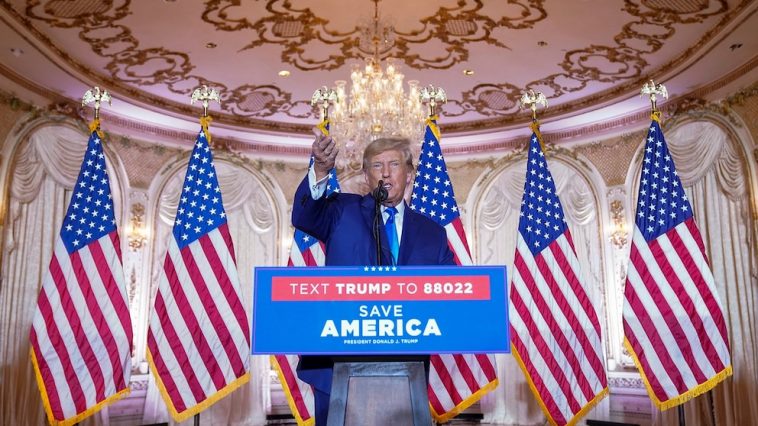This Monday, the Supreme Court upheld a decision that will allow Donald Trump’s name to feature prominently on the 2024 presidential primary ballots. Previously, there were attempts in several states to hold the former Republican president responsible for the incident at the Capitol. However, the apex court established the day prior to the decisive Super Tuesday primaries that states lack the authority to deploy a post-Civil War Constitutional clause to inhibit presidential candidates from appearing on the ballots. According to an unsigned opinion from the court, this power is the exclusive prerogative of Congress.
This decision successfully wraps up attempts in Colorado, Maine, Illinois and other locations to exclude Trump, currently the leading candidate for his party’s nomination, from the ballot. The primary reason cited for these actions was his efforts to refute the outcome of the 2020 election, which he lost to Democrat Joe Biden. These attempts generated a situation that resulted in the unfortunate incident on January 6, 2021, at the Capitol.
This lawsuit involving Trump is a pioneering instance at the Supreme Court concerning a clause from the 14th Amendment. This measure, born in the aftermath of the Civil War, aims to forbid former officers who had ‘engaged in insurrection’ from taking office again. The Supreme Court in Colorado, in a groundbreaking ruling, had determined this provision (Section 3) was applicable to Trump, judging that he had spurred the Capitol attack. However, no court had previously applied this Section 3 to a presidential candidate.
Election commentators are sounding the alarm that the judgment, mandating congressional approval to enforce Section 3, could pave the way for a revived debate around leveraging the provision to disqualify Trump, should he secure victory in the election. A hypothetical situation presents itself where a Congress under Democratic control could attempt to dismiss certification of Trump’s election victory on January 6, 2025, under this clause — potentially prompting a return of this contentious issue to the courts and causing further constitutional turbulence.
Both parties of the conflict urged the court for expedited proceedings. The justices had barely a month prior, on February 8, heard arguments and appeared then positioned to rule in Trump’s favor. The former president’s name had been removed from ballots in Colorado, Maine, and Illinois, but these decisions were temporarily halted, awaiting the judgment of the Supreme Court.
The case marks the most pronounced intervention by the court in a presidential election since Bush v. Gore. The verdict of this case, delivered a quarter-century earlier, effectively determined the 2000 election in favor of Republican George W. Bush. Additional cases continue to surface that could impact Trump’s prospects of reclaiming presidency, including a scheduled late April court hearing regarding the possibility of his criminal prosecution on charges of election interference, encompassing his role in the Capitol attack on January 6.
The scheduling of the Supreme Court’s intervention leads to speculation concerning Trump’s potential trial timing before the November election. It was the first occasion for the Supreme Court to hear a case involving the application of the 14th Amendment’s Section 3 clause during the February proceedings. This clause, just two sentences long and intended to deter certain Confederates from resuming office, states that individuals who breach their oaths to uphold the Constitution are disqualified from various positions including congressional offices or serving as presidential electors. However, it conspicuously omits reference to the presidency itself.
Questions arose from both conservative and liberal justices regarding the case against Trump. The key query focused on whether Congressional action should precede states’ invocation of the 14th Amendment. Doubts were also cast regarding the applicability of this provision to the president.
Lawyers representing the Republican and independent voters who filed a lawsuit to exclude Trump’s name from the Colorado ballot made the argument that the January 6 events qualify as an insurrection incited by Trump. Their contention lies in the claim that Trump encouraged his supporters at a rally outside the White House to ‘fight like hell.’ These attorneys have contested that applying Section 3 to anything but the presidency or exempting Trump was illogical. They also posited that the implementation of this provision requires no additional legislation.
Offering a counter-argument, Trump’s legal team defended multiple angles, arguing that the 14th Amendment couldn’t be used to exclude him from the ballot. They argued that the riot on January 6 didn’t meet the criteria of an insurrection, and if it did, Trump neither attended the riot nor joined rioters at the Capitol. They also asserted that the language of the amendment excludes the presidency and those pursuing presidential candidature.
Even if these arguments were discredited, Trump’s lawyers maintained that Congress would need to enact legislation to revitalize Section 3. The decision on this case has been delivered by a court that includes three justices appointed by Trump during his presidency. Over recent years, they have dealt with numerous cases directly or indirectly involving Trump. Some of these include declining his unfounded allegations of fraud in the 2020 election and refusing to protect his tax records from Congress and New York prosecutors.
The 5-to-4 verdict in the Bush v. Gore case, more than 23 years ago, was the last time the court became deeply entangled in presidential politics. Currently, Justice Clarence Thomas is the sole member of the court who was serving during that period. Despite calls from select Democratic lawmakers for him to recuse himself from the Trump case due to his wife, Ginni’s support for Trump’s efforts to contest the results of the 2020 election and her attendance at the pre-Capitol rally, he has steadfastly ignored these calls.


